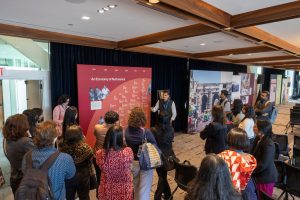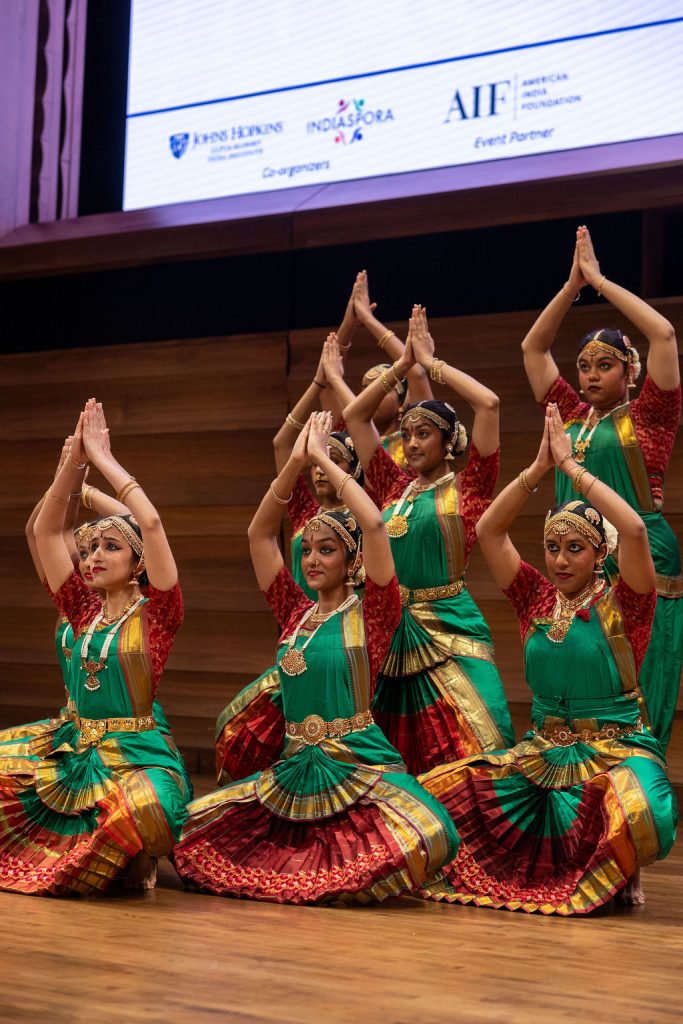Cultural Highlights
Beyond the panel discussions, HIC 2025 integrated rich cultural experiences that reinforced the conference’s themes of collaboration and inclusion.
SEWA Exhibit – “Hum Sab Ek: We Are One”
Throughout the conference, attendees could visit a special exhibit curated by the Self-Employed Women’s Association (SEWA) titled “Hum Sab Ek (We Are One): SEWA’s Response to the Pandemic.” This immersive exhibition, spread across two floors of the Bloomberg Center, showcased how SEWA’s women members mobilized during COVID-19 to support their communities – from producing face masks and sanitizer to organizing healthcare and financial relief for informal workers.
Curated by Dr. Satchit Balsari and Ms. Hiteshree Das, the exhibit combined powerful storytelling with data, photographs, and artifacts from SEWA’s fieldwork. Conference participants joined guided tours to learn how grassroots innovation saved lives and livelihoods in a time of crisis. The exhibit’s message – that unity and local leadership can overcome even global challenges – resonated deeply with the conference’s spirit. It provided a moving, first-hand look at community resilience, complementing the more policy-oriented discussions with a human touch. Many attendees cited the SEWA exhibit as an emotional highlight that grounded the conference in real-world impact.
JHU Shakti Performance
The conference concluded on a vibrant note with a  performance by JHU Shakti, Johns Hopkins University’s premier Indian classical dance team. In a packed auditorium, Shakti’s dancers delivered a captivating Bharatanatyam piece that was more than just a cultural showcase – it was art as advocacy. Their performance, introduced as “Dance as Tradition, Resistance, and Celebration,” shed light on the theme of caste discrimination. Through intricate choreography and expressive storytelling, the dancers depicted the journey from oppression to empowerment, weaving in the narrative of how a traditional art form can challenge social hierarchies.
performance by JHU Shakti, Johns Hopkins University’s premier Indian classical dance team. In a packed auditorium, Shakti’s dancers delivered a captivating Bharatanatyam piece that was more than just a cultural showcase – it was art as advocacy. Their performance, introduced as “Dance as Tradition, Resistance, and Celebration,” shed light on the theme of caste discrimination. Through intricate choreography and expressive storytelling, the dancers depicted the journey from oppression to empowerment, weaving in the narrative of how a traditional art form can challenge social hierarchies.
This theme was particularly poignant: Bharatanatyam itself was historically inaccessible to lower castes, so Shakti’s use of it to condemn caste bias was a powerful statement of inclusivity. The audience gave a standing ovation as the final pose was struck, recognizing both the artistic excellence and the courage of the message. For many, especially those new to Indian classical arts, the performance underscored how cultural expression can reinforce the conference’s knowledge agenda – reminding us that data and dialogue must be coupled with cultural empathy and understanding. The JHU Shakti troupe’s presence also symbolized Johns Hopkins’ commitment to celebrating India’s heritage as part of the institute’s community.
These cultural elements – the SEWA exhibit and Shakti’s dance – set the Hopkins India Conference apart from a typical academic event. They engaged attendees’ hearts and minds, illustrating that U.S.-India partnerships flourish not only in conference rooms and laboratories but also through shared culture and human stories.